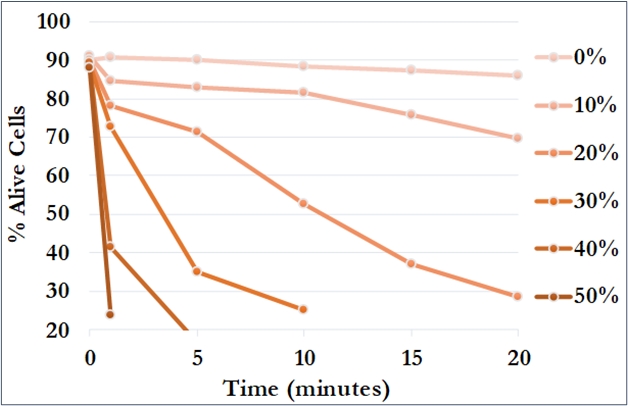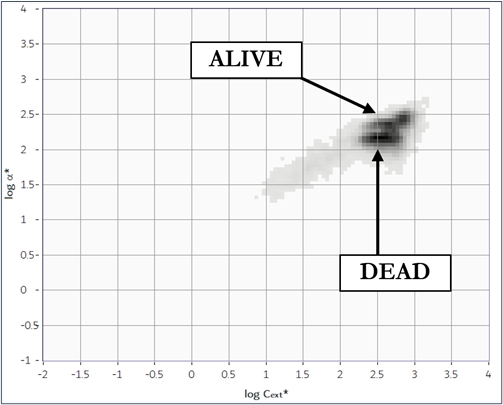[vc_row full_width_row=”true”][vc_column][vc_column_text][maxmegamenu location=max_mega_menu_3][/vc_column_text][/vc_column][/vc_row][vc_row][vc_column][vc_column_text]
The cell viability is defined as a percentage of live cells in a whole population. The determination of yeast cell viability is commonly used to assessing the impact of various types of stressors in toxicity research and in industrial microbiology studies. The yeast Saccharomyces cerevisiae is a very useful model organism used for studies of cyto- or genotoxicity under different kinds of chemical, physical, or environmental factors. The analysis of the cell viability is also very important for industrial processes where microorganisms are used, as food, beverage, and biofuel. The Classizer™ ONE provides an accurate estimation of the cell viability regardless the presence of secondary populations and impurities.
[/vc_column_text][/vc_column][/vc_row][vc_row][vc_column width=”1/3″][vc_column_text]In comparison with current fluorescence kit available on the market, SPES/SPES² have mayor advantages:
- automatically reliable measure of ten thousand counts is performed.
- not time consuming: each single measure of this application note lasts less than few minutes.
- no expensive consumables.
- Iimited or even no sample treatment, except for a simple and automatable pre-dilution.
- inline/online monitoring in an industrial processes.
[/vc_column_text][/vc_column][vc_column width=”1/3″][vc_message message_box_style=”solid-icon” message_box_color=”blue” icon_fontawesome=”fa fa-lightbulb-o” css_animation=”fadeIn”]Example of application: mix of alive and dead yeast cells
Optical classification of a yeast aqueous suspension. From the optical point of view, yeast cells are sightly elliptic particles with a narrow size distribution peaked at around 4μm. A yeast cell can have an uncontrolled accidental or a regulated death (apoptosis). In case of death, the cell shrinks itself by about 25-28% of his volume. Due to the loss of liquid, the overall refractive index of the particle increases too. These effect can be clearly observed and studied with SPES/SPES² techniques.
(in figure) EOS CLOUDS of a mix of a sample with alive yeast cells and dead yeast cells.[/vc_message][/vc_column][vc_column width=”1/3″][vc_message message_box_style=”solid-icon” message_box_color=”blue” icon_fontawesome=”fa fa-lightbulb-o” css_animation=”fadeIn”]Example of application: mix of alive and dead yeast cells
Classizer™ ONE can perform a real-time monitoring of an inline production process to determine sample differences for an indefinite time with the CFA (Continuous Flow Analysis) addon. In this example, from an initial sample of living yeast cells in Milliq-grade water, different percentages of ethanol are added and then continuously measured for 20 minutes. An area was then selected on the two-dimensional histogram compatible with the position of the living cells, to be able to calculate the percentage of measured particles that fall inside and inside that area.
 (in figure) Evolution of living cells in a mix of water / ethanol in increasing percentages of the latter. [/vc_message][/vc_column][/vc_row][vc_row][vc_column][dt_button link=”https://www.eosinstruments.com/publications/” button_alignment=”center” animation=”fadeInDown” size=”big”]Find out more > EOS Application Note EOS AN016 Multiparametric Determination of Yeast Cell Viability via SPES Technology[/dt_button][/vc_column][/vc_row]
(in figure) Evolution of living cells in a mix of water / ethanol in increasing percentages of the latter. [/vc_message][/vc_column][/vc_row][vc_row][vc_column][dt_button link=”https://www.eosinstruments.com/publications/” button_alignment=”center” animation=”fadeInDown” size=”big”]Find out more > EOS Application Note EOS AN016 Multiparametric Determination of Yeast Cell Viability via SPES Technology[/dt_button][/vc_column][/vc_row]
